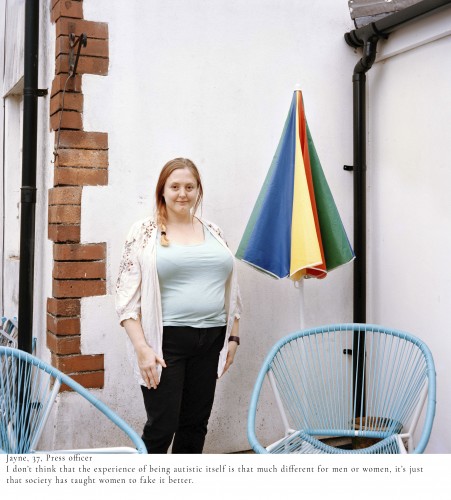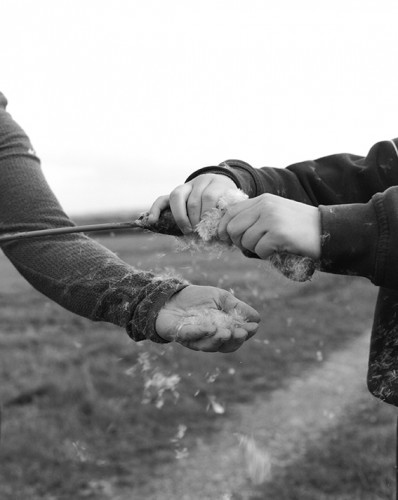The use of classic autistic male characteristics for diagnostic parameters has meant that generations of women have been overlooked and often arrive at a diagnosis decades after their male counterparts.
Millennium
Can you tell us a little bit more about your project “No You’re Not – A Portrait of Autistic Women” and your photos selected for the “Taylor Wessing Photographic Portrait Prize”
Rosie Barnes
I started the project because I wanted to ‘lift the lid’ and challenge so many persistent untruths about autistic women and girls.
The use of classic autistic male characteristics for diagnostic parameters has meant that generations of women have been overlooked and often arrive at a diagnosis decades after their male counterparts.
This group of women, are the least likely to be believed to be autistic. The title ‘No You’re Not’, is a regular response when these women are disclosing their diagnosis. The irony is that their struggles are often greater because of their achievements, often in education or work, meaning they are even less likely to be believed and more likely to be misunderstood. I wanted to enable these women to tell their stories and to challenge our understanding and acceptance of different neurotypes, in a society where there are so few opportunities to be seen or heard.
Having interviewed and photographed around a dozen women, I was lucky enough, last year, to be commissioned by the Wellcome Collection to extend the project. ‘Margaret’ and ‘Jayne’, the two portraits selected for TW, are both from that extension.
Millennium
Is there a meaning behind your portraits? What do you want the viewer to take from the imagery?
Rosie Barnes
I just want the viewer to see these women as individuals. Women who are our colleagues, our friends, our neighbours, but who might well be masking (hiding) their true selves in order to fit in to the expectations of a neuro-typical world… and may have done so for many years, at the cost of their own mental health.
The words, from our conversations, have an equal weight to the portraits and it’s important to me that they’re always shown alongside their words.
Millennium
Did your interest in photographing these women come naturally? What is your relationship with them?
Rosie Barnes
There is neurodiversity in my extended family. I have previously made work about my eldest son who is autistic and has a learning disability. I used to run a support group for parents, mostly mothers (of autistic children) and when one or two disclosed that they thought they might be autistic too, I realised, from the surprised response, that it was an area that really needed a light shining on it. It was hard to recruit women to start with, but once I had interviewed and photographed one or two, it became a lot easier and now people contact me wanting to be part of the project. I work very slowly and respectfully and make contact initially and continue conversations via email and then sometimes on zoom, before actually meeting. I like to make it clear that we are collaborating together and that they can have full control over how they are represented. There’s a great deal of mutual respect in this project.
Millennium
Why did you decide to apply to the prize?
Rosie Barnes
I did have a portrait selected many years ago for Taylor Wessing’s pre-runner, the NPG/John Kobal Award. I have since entered the Taylor Wessing Prize a few times (but not every year) and been unsuccessful. This year I really felt I had work that was strong enough.
Millennium
How does it feel to be part of such a prestigious award?
Rosie Barnes
Taylor Wessing remains one of the most prestigious photo awards, so I was completely overjoyed to have two portraits selected for the exhibition. I was also delighted as I am passionate about this subject and I knew it would bring more understanding by being in such a prestigious, well attended exhibition. Autism is still under-diagnosed in girls and women and there are many older women out there who feel somehow broken.
Millennium
What type of equipment you use, what camera you used?
Rosie Barnes
I used my trusted medium format Mamiya twin lens C330. I have two of them. It was the first medium format camera I ever used and I have just never felt the need to use anything else. I find the waist level view finder brilliant for portraits as I don’t like to point my camera into someone’s face with me hiding behind it. Being one step ‘removed’, in that way, from the subject gives the space for the subject to really relax and ‘open up’ to me, in a way that I find happens less when I’m using a standard SLR.
I used Kodak Portra – always my film of choice, though the price has been steadily going through the roof and is pretty much unaffordable now, which is pretty depressing, to say the least. This might end up being the last major project I shoot on film.
Millennium
What’s next for you?
Rosie Barnes
I am continuing with the project and such is the incredibly positive feedback I’ve had, I’d like to create a photobook that could be invaluable for not only autistic women and girls themselves, allowing them to feel less alone, but also the misinformed professionals, who are often relying on outdated and misguided information about autistic women in our society.
Rosie is a Millenium Images contributor, you can follow her on Instagram here and for further portraits and interviews in this series, please click here.










